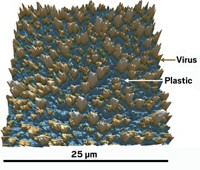Advertisement
Grab your lab coat. Let's get started
Welcome!
Welcome!
Create an account below to get 6 C&EN articles per month, receive newsletters and more - all free.
It seems this is your first time logging in online. Please enter the following information to continue.
As an ACS member you automatically get access to this site. All we need is few more details to create your reading experience.
Not you? Sign in with a different account.
Not you? Sign in with a different account.
ERROR 1
ERROR 1
ERROR 2
ERROR 2
ERROR 2
ERROR 2
ERROR 2
Password and Confirm password must match.
If you have an ACS member number, please enter it here so we can link this account to your membership. (optional)
ERROR 2
ACS values your privacy. By submitting your information, you are gaining access to C&EN and subscribing to our weekly newsletter. We use the information you provide to make your reading experience better, and we will never sell your data to third party members.
Analytical Chemistry
Noninvasive Glucose Detection
Gold nanoparticle method detects glucose at the low levels found in healthy people
by Celia Henry Arnaud
March 28, 2006
| A version of this story appeared in
Volume 84, Issue 14

Using gold nanoparticles, researchers at the University of Central Florida in Orlando can noninvasively detect low levels of glucose in human tears.
"The detection limit is low enough to detect levels of glucose in healthy persons," chemistry professor Florencio Hernandez told C&EN. "The idea is to use this method to determine glucose concentrations at very early stages. You can actually detect potential diabetic problems before diabetes becomes a problem."
When glucose is in solution, some of it is present in the open—chain aldehyde form. Hernandez, graduate student Marisol Garcia, and coworkers use gold nanoparticles to detect glucose with a test—based on the familiar Tollen's silver mirror test for aldehydes—in which they detect the aldehyde through a reaction with chloroauric acid. They described their work in a poster session Sunday night sponsored by the Division of Analytical Chemistry at the ACS national meeting in Atlanta.
Hernandez expected the glucose detection to work just like a mercury sensor his team had made previously. In that case, gold nanorods were suspended in a gold salt solution. When mercury is added to the solution, the mercury and gold form an amalgam that changes the effective length of the nanorods and shifts one of the surface plasmon resonance bands in the absorbance spectrum. The mercury test is sensitive to concentrations as low as parts per quadrillion.
The glucose sensor, however, didn't behave in the same way. "There were some interferences from gluconic acid, which stabilizes metal nanoparticles," Hernandez said. "You start generating nanospheres instead of growing the nanorods."
As more nanospheres form, a spectral feature known as the extinction efficiency changes proportionally to the glucose concentration. The researchers measure the absorbance spectrum using a UV-Vis spectrometer from Ocean Optics that is the size of a cigarette box.
The best fluid for doing the test is tears, Hernandez said. The glucose concentration in tears is known to correlate with the blood glucose concentration. "We're thinking about how many drops of tears we're going to need," he said. "We hope that a couple of tears will be more than enough to determine the concentration." The number of tears necessary will depend on the glucose concentration, so diabetics will need fewer tears than people who don't have the disease. The researchers haven't used the sensor yet with patients, so Hernandez isn't sure whether they will need to be induced to cry. He and his students joke about needing to use something that smells like onions.
The method is already sensitive enough to detect glucose in healthy individuals, but Hernandez wants to drive the sensitivity even lower, so that he can use the method to monitor the effects of diet on glucose levels in healthy people. In addition, contrary to other tests that measure glucose, this method is truly noninvasive. Even the methods that use contact lenses are "pseudoinvasive," Hernandez said. He sees the method as a tool for both researchers and patients.



Join the conversation
Contact the reporter
Submit a Letter to the Editor for publication
Engage with us on Twitter